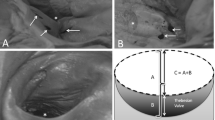Summary
Interest in transseptal catheterization has increased in recent decades, due to the fact that the technique has acquired a degree of security similar to other procedures. For a correct transseptal catheterization technique, it is essential to know the exact location of the fossa ovalis, its points of reference, and those morphologic parameters which allow us to assume precisely its dimensions. For this purpose, 97 human fresh hearts were studied (age range: 17–94 years; mean 63.74±18.50, 62 (64%) men and 35 (36%) women). The major and minor diameters of the fossa ovalis and the thickness of the intervenous tubercle were measured. In 22% of the cases, the fossa ovalis was permeable. Correlative tests between morphologic and general parameters were made. A positive correlation between cardiac weight and fossa ovalis area, and cardiac weight and thickness of the anterior limbus of the fossa was obtained.
Résumé
Le cathétérisme transseptal a vu son intérêt augmenter au cours de ces dernières décennies, en raison de l'innocuité de cette technique comparable aux autres investigations. La réalisation d'un cathétérisme transseptal nécessite une parfaite connaissance du siège de la fosse ovale, de ses dimensions et de ses paramètres morphologiques, ce qui nous a amenés à repréciser ses dimensions. A cet effet, 97 cœurs humains frais ont été étudiés (âges extrêmes : 17 à 94 ans ; moyenne d'âge 63,74±18,50, la série comportait 62 cœurs masculins (64 %) et 35 % cœurs féminins (36 %). Ont été mesurés : le grand et le petit diamètre de la fosse ovale, l'épaisseur de l'extrémité antérieure et de l'extrémité postérieure du limbe de la fosse ovale (a. de Vieussens) et l'épaisseur du tubercule interveineux (t. de Lower). La fosse ovale était perméable dans 22 % des cas. Des tests de relation entre les paramètres morphologiques et généraux ont été effectués. Des relations significatives entre le poids du coeur et la surface de la fosse ovale, et entre le poids du coeur et l'épaisseur de l'extrémité antérieure du limbe de la fosse ovale ont été trouvées.
Similar content being viewed by others
References
Bidoggia H, Maciel JP, Alvarez JA (1991) Transseptal left heart catheterization: Usefulness of the intracavitary electrocardiogram in the localization of the fossa ovalis. Cathet Cardiovasc Diagn 24: 221–225
Bloomfield DA, Sinclair-Smith BC (1965) The limbic ledge. A landmark for transseptal left heart catheterization. Circulation 31: 103–107
Calvo-Orbe L, Sobrino N, Oliver J, Mate I, Rico J, Mesa JM, Iglesias A, Sobrino JA (1988) Cateterismo transeptal: una técnica que resurge. Rev Esp Cardiol 41: 414–420
Clugston R, Lau FYK, Ruiz C (1992) Transseptal catheterization update 1992. Cathet Cardiovasc Diagn 26: 266–274
Cope C (1959) Technique for transseptal catheterization of the left atrium: Preliminary report. J Thorac Cardiovasc Surg 37: 482–486
Hagen PT, Scholz DG, Edwards WD (1984) Incidence and size of patent foramen ovale during the first 10 decades of life: An autopsy study of 965 normal hearts. Mayo Clin Proc 59: 17–20
Jornet A, Reig J, Ruiz C, Usón M, Petit M (1990) The intervenous tubercle (of Lower): Morphologic characteristics and changes in relation to age. Arch Anat Histol Embryol 73: 21–32
Jornet A, Batalla J, Usón M, Mallol A, Reig J, Petit M (1992) Lipomatous hypertrophy of interatrial septum: Diagnosis by transesophageal echocardiography. Echocardiography 9: 501–503
McKay RG, Lock JE, Keane JF, Safian RD, Aroesty JM, Grossman W (1986a) Percutaneous mitral valvuloplasty in an adult patient with calcific rheumatic mitral stenosis. J Am Col Cardiol 7: 1410–1415
McKay RG, Safian RD, Lock JE, Mandell VS, Thurer RL, Grossman W (1986b) Balloon dilatation of calcific aortic stenosis in elderly patients: Postmortem, intraoperative and percutaneous valvuloplasty studies. Circulation 74: 119–125
Mullins CE (1983) Transseptal left heart catheterization: Experience with a new technique in 520 pediatric and adult patients. Pediatr Cardiol 4: 239–245
Nagasawa K, Kimura E, Hayashi C (1979) The estimation of heart weight from routine chest Xray films. Jap Heart J 20: 105–115
Page DL (1970) Lipomatous hypertrophy of the cardiac interatrial septum. Hum Pathol 1: 151–162
Patten BM (1931) The closure of the foramen ovale. Am J Anat 48: 19–44
Prothero J (1979) Heart weight as a function of body weight in mammals. Growth 43: 139–150
Rashkind WJ, Miller WW (1966) Creation of an atrial septal defect without thoracotomy. JAMA 196: 991–992
Rosenquist GC, Sweeney LJ, Ruckman RN, McAllister HA (1979) Atrial septal thickness and area in normal heart specimens and in those with ostium secundum atrial septal defects. J Clin Ultrasound 7: 345–348
Ross J, Braunwald E, Morrow AG (1959) Transseptal left atrial puncture: A new method for the measurement of left atrial pressure in man. Am J Cardiol 3: 653–655
Sweeney LJ, Rosenquist GC (1979) The normal anatomy of the atrial septum in the human heart. Am Heart J 98: 194–199
Weiner RI, Maranhao V (1988) Development and applications of transseptal left heart catheterization. Cathet Cardiovasc Diagn 15: 112–120
Author information
Authors and Affiliations
Rights and permissions
About this article
Cite this article
Reig, J., Mirapeix, R., Jornet, A. et al. Morphologic characteristics of the fossa ovalis as an anatomic basis for transseptal catheterization. Surg Radiol Anat 19, 279–282 (1997). https://doi.org/10.1007/BF01637589
Received:
Accepted:
Issue Date:
DOI: https://doi.org/10.1007/BF01637589




